By Ken Lain, the mountain gardener
It’s surprising how many winter birds grace our dormant gardens with their graceful flight and beautiful sounds. Many have migrated from far cooler climates in the north, and 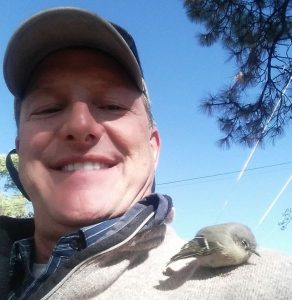 actually find Prescott weather to be sunshiny and warm! It’s nice to put out bird feeders with seed and suet to attract birds to our yards, but birds need to forage and find their own food. It’s especially important to have food for them to find when feeders are empty. There are many wonderful plants with fruits and berries that birds like during our cold months. Many of these plants are available at the nursery right now, but less often recognized are the garden flowers that have seed most birds gobble up with gusto. Along with nourishment, many plants provide shelter and nesting materials.
actually find Prescott weather to be sunshiny and warm! It’s nice to put out bird feeders with seed and suet to attract birds to our yards, but birds need to forage and find their own food. It’s especially important to have food for them to find when feeders are empty. There are many wonderful plants with fruits and berries that birds like during our cold months. Many of these plants are available at the nursery right now, but less often recognized are the garden flowers that have seed most birds gobble up with gusto. Along with nourishment, many plants provide shelter and nesting materials.
It’s not too late to plant some of our most popular local perennials that winter birds find so attractive. If you have these in the yard already, wait until March to cut them back so birds have time to find and use them. The same goes for new plantings. A couple of these hardy perennials are evergreen, but even the varieties that aren’t should be planted and left uncut until the birds make it through the harshest part of winter.
As a bird gardener, here are my top plant picks to attract and help local bird species:
Sedum – Most of us keep dried sedums in our gardens for winter interest. They seem 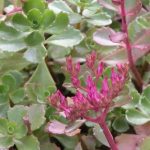 to start re-growing as soon as the old leaves die. Even the ground hugging Sedum varieties are popular with pretty much all types of feathered seedeaters.
to start re-growing as soon as the old leaves die. Even the ground hugging Sedum varieties are popular with pretty much all types of feathered seedeaters.
Coreopsis – If you thought all that cheerful yellow 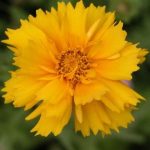 throughout the summer was the only contribution your coreopsis plants make to your garden, watch for the many winter songbirds attracted to their seeds.
throughout the summer was the only contribution your coreopsis plants make to your garden, watch for the many winter songbirds attracted to their seeds.
Asters – There are many varieties of asters and they all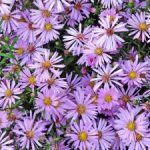 attract some type of bird, among them are: cardinals, chickadees, goldfinches, indigo buntings, nuthatches, sparrows, towhees, and warblers.
attract some type of bird, among them are: cardinals, chickadees, goldfinches, indigo buntings, nuthatches, sparrows, towhees, and warblers.
Black Eyed Susan, or Rudbeckia – Like coneflowers, 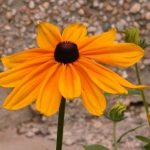 black-eyed Susans are prairie garden staples that remain standing through most of the winter. American goldfinches, chickadees, cardinals, nuthatches, sparrows, and towhees feed enthusiastically on Rudbeckia seeds
black-eyed Susans are prairie garden staples that remain standing through most of the winter. American goldfinches, chickadees, cardinals, nuthatches, sparrows, and towhees feed enthusiastically on Rudbeckia seeds
Coneflower – With its sturdy stems this plant can remain 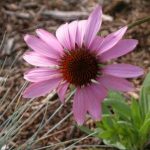 standing long into the wettest, snowiest winter. Among the birds seen pecking at coneflowers are the American goldfinch and the pine siskin.
standing long into the wettest, snowiest winter. Among the birds seen pecking at coneflowers are the American goldfinch and the pine siskin.
Globe Thistle – Unlike the nyjar thistle, used in birdseed 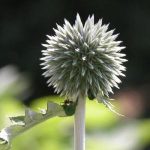 mixes, this is an attractive plant and not usually aggressive. Globe thistle seeds are especially popular with goldfinches.
mixes, this is an attractive plant and not usually aggressive. Globe thistle seeds are especially popular with goldfinches.
Goldenrod, or Saladgo – A valuable addition to a bird-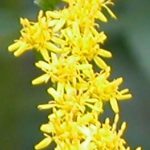 lover’s garden, goldenrod packs a double punch. Several birds, like finches, pine siskins, yellow-rumped warblers, and indigo buntings munch on its seeds. But it’s also a popular overwintering site for insects that are relished in a winter bird’s diet. So birds get a well-balanced meal from one plant!
lover’s garden, goldenrod packs a double punch. Several birds, like finches, pine siskins, yellow-rumped warblers, and indigo buntings munch on its seeds. But it’s also a popular overwintering site for insects that are relished in a winter bird’s diet. So birds get a well-balanced meal from one plant!
Joe Pye Weed, or Eupatorium – Chickadees, wrens, titmice, and juncos love to eat this 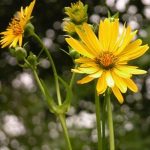 plant’s seeds. They also like to use the fluff for building warm nests.
plant’s seeds. They also like to use the fluff for building warm nests.
Silphium – Cup plant, prairie dock, and compass plant are some of the many common names for this tall, daisy-like flower. It can be quite a sight in the garden with flowers abloom way at the top of its long stems. Birds, especially finches, prefer their seeds as they are beginning to dry.
Zinnia – If you’ve grown zinnias and collected their seeds, you know how many there 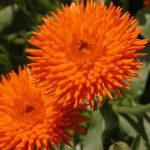 are in each flower. The tiny seeds on a single plant can keep sparrows or goldfinches busy for an entire afternoon! Other annuals to keep around for seed include impatiens and autumn marigolds.
are in each flower. The tiny seeds on a single plant can keep sparrows or goldfinches busy for an entire afternoon! Other annuals to keep around for seed include impatiens and autumn marigolds.
Evergreens – I know that evergreens are not flowers, but don’t overlook the amount of shelter a nice strong spruce, cypress, or cedar can provide for winter birds. If you are into decorating for the holidays the birds will REALLY appreciate your decorated evergreen. There are several species will congregate under the heat and welcome extra warmth provided by all those lights. So dress up that outdoor tree; the birds will be all the happier, and so will the neighborhood.
Thanksgiving – From our family to yours, we hope that you will enjoy the spirit of Thanksgiving Day, our uniquely American holiday.
Until next week, I’ll see you at the garden center.
Ken Lain can be found throughout the week at Watters Garden Center, 1815 W. Iron Springs Rd in Prescott, or contacted through his web site at WattersGardenCenter.com or FB.com/WattersGardenCenter


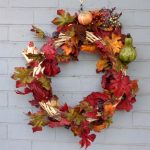
Can I order nemodes from you now?and when do I apply them into the soil? I have 4 grow pots with veggies,and would like to stop them this time before they devour my kale and all the other plants,thnks.
Nemodes,do you ship? When is the best time to apply them,i have 4 grow pots with veggies,last we had an invasion of web building pests………want to get a jump start onthis……………thanks.